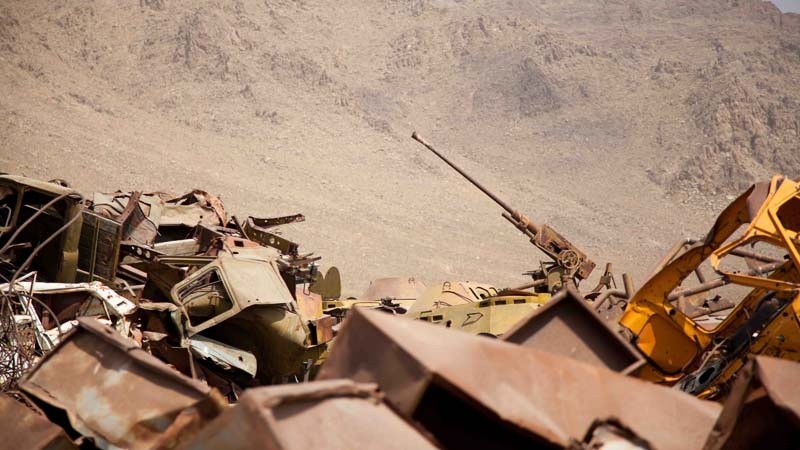“The Afghans have a saying,” said Captain Vosnos, swinging the muzzle of his rifle in a wide arc: “After God created the Earth, he had a bunch of rocks and sand left over, so he made Afghanistan.” That described the grounds of the Kabul Military Training Center perfectly. I had first arrived at the facility earlier in the week to see Afghanistan’s finest military cadets execute elegant ambushes, neutralize IEDs, and blast paper targets with machine guns under the rude sun. The background to these exercises, quite appropriately, was the expansive plain we were now standing on—a brown landscape strewn with decaying tanks and equipment abandoned by the Soviets back in 1989 at the end of their decade-long failed invasion.I had come here to photograph the rusted mountain of Soviet military hardware lurking on the center's grounds, but before I even got out my camera, we had to get rid of the dogs who hang around the wreckage in ragged packs, which is what Vosnos was here for.“I’ve got 30 rounds in my M-4 and 15 in my Beretta,” he said. “So we can handle 45 dogs, but the 46th is gonna be a bitch.” The dog pack in front of us, hearing this, began to growl even louder. Most of them, I had been told, are rabid—and the canine carcasses littering the area attested to that.Vosnos signaled for me to hang back as he raised his weapon and stepped slowly toward the pack. The rigid postures of the dogs slackened. Living on a military training ground, the animals had learned what an assault rifle could do. Seeing one pointing at them was all it took to make them tuck their tails and scamper. We watched them slink back into the sea of broken tanks. A French trainer had told me that the tanks were a valuable asset. He said that any time the Afghan soldiers in his charge complained of hardship or lack of equipment, he would point to the tanks and counter, “Your fathers defeated the Soviets with muskets, and your grandfathers defeated the British with swords. Are you any less fierce?” And that would be the end of that.As I clambered over the tanks with camera in hand, Vosnos scanned the terrain.“What are you looking for?” I asked.“We’re inside a base,” he said, “so it is pretty safe, but there are villages inside the perimeter. Some are friendly, some are neutral, and some are hostile.”“How can you tell they’re hostile?” I asked.“Mostly the rock throwing,” he replied.Grinning, I climbed down to rejoin him. We moved on, farther and farther into the landscape of a former war, swiveling our eyes up and down as we went—up for people and dogs, and down for unexploded ordnance. The night before, when I heard the area might be mined, I had called my cousin, a six-foot-five cigar-chomping officer in the US Army who had been stationed at KMTC and had personally handled the contract to de-mine the area back in 2010.“If you see no one around,” he advised, “and it looks like the path hasn’t been touched since the moon landing, don’t go there. They pretty much have sectioned off most of the land mines with rocks. So is there a chance you’ll get hit? I’d say about five times more likely than getting hit by a meteor.”Roc’s new book, And, was released last year. You can find more information on his website.More on Afghanistan:Swimming with WarlordsReading Taliban Love Poems in an Afghan PrisonCSI Afghanistan: Solving Murders in a War Zone
A French trainer had told me that the tanks were a valuable asset. He said that any time the Afghan soldiers in his charge complained of hardship or lack of equipment, he would point to the tanks and counter, “Your fathers defeated the Soviets with muskets, and your grandfathers defeated the British with swords. Are you any less fierce?” And that would be the end of that.As I clambered over the tanks with camera in hand, Vosnos scanned the terrain.“What are you looking for?” I asked.“We’re inside a base,” he said, “so it is pretty safe, but there are villages inside the perimeter. Some are friendly, some are neutral, and some are hostile.”“How can you tell they’re hostile?” I asked.“Mostly the rock throwing,” he replied.Grinning, I climbed down to rejoin him. We moved on, farther and farther into the landscape of a former war, swiveling our eyes up and down as we went—up for people and dogs, and down for unexploded ordnance. The night before, when I heard the area might be mined, I had called my cousin, a six-foot-five cigar-chomping officer in the US Army who had been stationed at KMTC and had personally handled the contract to de-mine the area back in 2010.“If you see no one around,” he advised, “and it looks like the path hasn’t been touched since the moon landing, don’t go there. They pretty much have sectioned off most of the land mines with rocks. So is there a chance you’ll get hit? I’d say about five times more likely than getting hit by a meteor.”Roc’s new book, And, was released last year. You can find more information on his website.More on Afghanistan:Swimming with WarlordsReading Taliban Love Poems in an Afghan PrisonCSI Afghanistan: Solving Murders in a War Zone
ΔΙΑΦΗΜΙΣΗ

ΔΙΑΦΗΜΙΣΗ
